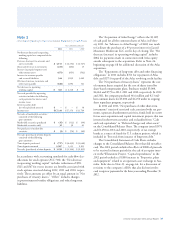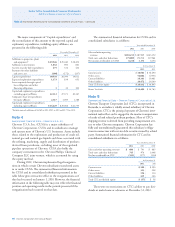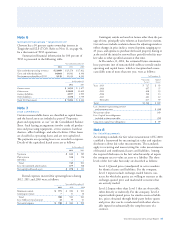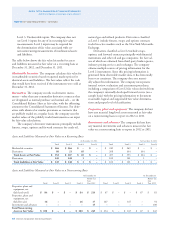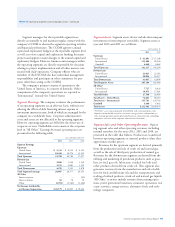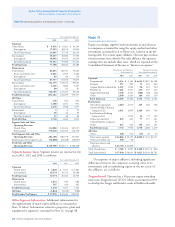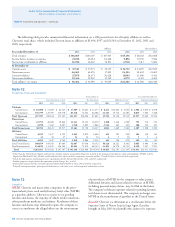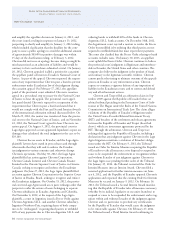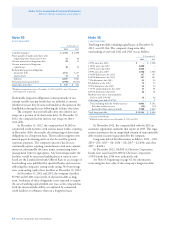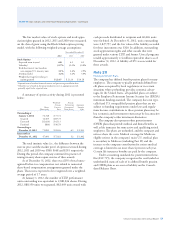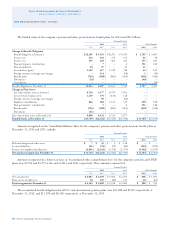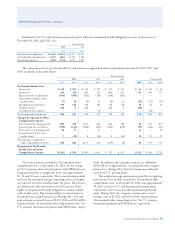Chevron 2012 Annual Report Download - page 51
Download and view the complete annual report
Please find page 51 of the 2012 Chevron annual report below. You can navigate through the pages in the report by either clicking on the pages listed below, or by using the keyword search tool below to find specific information within the annual report.
Chevron Corporation 2012 Annual Report 49
tatives of certain residents of an area where an oil production
consortium formerly had operations. e lawsuit alleges dam-
age to the environment from the oil exploration and
production operations and seeks unspecied damages to fund
environmental remediation and restoration of the alleged
environmental harm, plus a health monitoring program. Until
1992, Texaco Petroleum Company (Texpet), a subsidiary of
Texaco Inc., was a minority member of this consortium with
Petroecuador, the Ecuadorian state-owned oil company, as the
majority partner; since 1990, the operations have been con-
ducted solely by Petroecuador. At the conclusion of the
consortium and following an independent third-party envi-
ronmental audit of the concession area, Texpet entered into a
formal agreement with the Republic of Ecuador and Petroec-
uador for Texpet to remediate specic sites assigned by the
government in proportion to Texpet’s ownership share of the
consortium. Pursuant to that agreement, Texpet conducted a
three-year remediation program at a cost of $40. After certify-
ing that the sites were properly remediated, the government
granted Texpet and all related corporate entities a full release
from any and all environmental liability arising from the con-
sortium operations.
Based on the history described above, Chevron believes
that this lawsuit lacks legal or factual merit. As to mat-
ters of law, the company believes rst, that the court lacks
jurisdiction over Chevron; second, that the law under which
plaintis bring the action, enacted in 1999, cannot be applied
retroactively; third, that the claims are barred by the statute
of limitations in Ecuador; and, fourth, that the lawsuit is also
barred by the releases from liability previously given to Tex-
pet by the Republic of Ecuador and Petroecuador and by the
pertinent provincial and municipal governments. With regard
to the facts, the company believes that the evidence conrms
that Texpet’s remediation was properly conducted and that
the remaining environmental damage reects Petroecuador’s
failure to timely fulll its legal obligations and Petroecuador’s
further conduct since assuming full control over the opera-
tions.
In 2008, a mining engineer appointed by the court to
identify and determine the cause of environmental dam-
age, and to specify steps needed to remediate it, issued a
report recommending that the court assess $18,900, which
would, according to the engineer, provide nancial com-
pensation for purported damages, including wrongful death
claims, and pay for, among other items, environmental
remediation, health care systems and additional infrastruc-
ture for Petroecuador. e engineer’s report also asserted
that an additional $8,400 could be assessed against Chevron
for unjust enrichment. In 2009, following the disclosure by
Chevron of evidence that the judge participated in meetings
in which businesspeople and individuals holding themselves
out as government ocials discussed the case and its likely
outcome, the judge presiding over the case was recused. In
2010, Chevron moved to strike the mining engineer’s report
and to dismiss the case based on evidence obtained through
discovery in the United States indicating that the report was
prepared by consultants for the plaintis before being pre-
sented as the mining engineer’s independent and impartial
work and showing further evidence of misconduct. In August
2010, the judge issued an order stating that he was not bound
by the mining engineer’s report and requiring the parties to
provide their positions on damages within 45 days. Chevron
subsequently petitioned for recusal of the judge, claiming
that he had disregarded evidence of fraud and misconduct
and that he had failed to rule on a number of motions within
the statutory time requirement.
In September 2010, Chevron submitted its position
on damages, asserting that no amount should be assessed
against it. e plaintis’ submission, which relied in part on
the mining engineer’s report, took the position that damages
are between approximately $16,000 and $76,000 and that
unjust enrichment should be assessed in an amount between
approximately $5,000 and $38,000. e next day, the judge
issued an order closing the evidentiary phase of the case and
notifying the parties that he had requested the case le so
that he could prepare a judgment. Chevron petitioned to
have that order declared a nullity in light of Chevron’s prior
recusal petition, and because procedural and evidentiary
matters remained unresolved. In October 2010, Chevron’s
motion to recuse the judge was granted. A new judge took
charge of the case and revoked the prior judge’s order closing
the evidentiary phase of the case. On December 17, 2010,
the judge issued an order closing the evidentiary phase of the
case and notifying the parties that he had requested the case
le so that he could prepare a judgment.
On February 14, 2011, the provincial court in Lago
Agrio rendered an adverse judgment in the case. e court
rejected Chevron’s defenses to the extent the court addressed
them in its opinion. e judgment assessed approximately
$8,600 in damages and approximately $900 as an award
for the plaintis’ representatives. It also assessed an addi-
tional amount of approximately $8,600 in punitive damages
unless the company issued a public apology within 15 days
of the judgment, which Chevron did not do. On Febru-
ary 17, 2011, the plaintis appealed the judgment, seeking
increased damages, and on March 11, 2011, Chevron
appealed the judgment seeking to have the judgment nulli-
ed. On January 3, 2012, an appellate panel in the provincial
court armed the February 14, 2011 decision and ordered
that Chevron pay additional attorneys’ fees in the amount
of “0.10% of the values that are derived from the decisional
act of this judgment.” e plaintis led a petition to clarify
Note 13 Litigation – Continued


